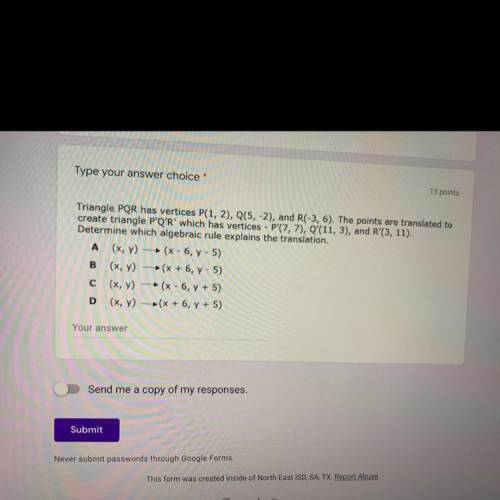
Mathematics, 27.01.2021 05:00 princessjsl22
Triangle PQR has vertices P(1, 2), Q(5,-2), and R(-3, 6). The points are translated to
create triangle P'Q'R' which has vertices - P'(7, 7), Q'(11, 3), and R'(3, 11).
Determine which algebraic rule explains the translation.
А (x, y) - (x - 6, y - 5)
B (x, y) (x + 6, Y - 5)
C (x, y) = (x - 6, y + 5)
D (x, y) (x + 6, y + 5)


Answers: 2


Another question on Mathematics

Mathematics, 21.06.2019 13:40
Which compound inequality can be used to solve the inequality 3x+2 > 7? -7 < 3x+2> 7 -7> 3x+27 3x + 2 > -7 or 3x + 2 > 7 3x + 2 < -7 or 3x + 2 > 7
Answers: 1



Mathematics, 21.06.2019 23:00
Delbert keeps track of total of the total number of points he earns on homework assignments, each of which is worth 60 points. at the end of the semester he has 810 points. write an equation for delbert’s average homework score a in terms of the number of assignments n.
Answers: 3
You know the right answer?
Triangle PQR has vertices P(1, 2), Q(5,-2), and R(-3, 6). The points are translated to
create trian...
Questions



English, 20.07.2019 05:00

English, 20.07.2019 05:00

English, 20.07.2019 05:00


English, 20.07.2019 05:00

English, 20.07.2019 05:00

English, 20.07.2019 05:00

English, 20.07.2019 05:00







History, 20.07.2019 05:00

Computers and Technology, 20.07.2019 05:10

Computers and Technology, 20.07.2019 05:10




